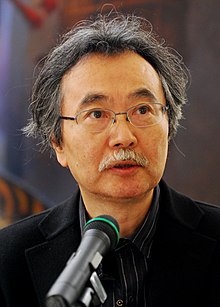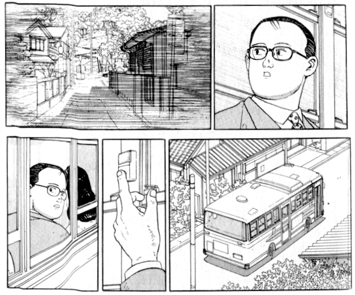Jiro Taniguchi | |
|---|---|
 Taniguchi at Lucca Comics and Games in 2011 | |
| Born | 14 August 1947 Tottori, Tottori, Japan |
| Died | 11 February 2017 (aged 69) Tokyo, Japan |
| Occupation | Manga artist |
| Nationality | Japanese |
| Notable works | |
| Notable awards | Tezuka Osamu Cultural Prize (1998) |
| Signature | |
Jiro Taniguchi (谷口 ジロー, Taniguchi Jirō, 14 August 1947 – 11 February 2017)[1] was a Japanese manga writer/artist. His works belong to the gekiga, or "dramatic pictures", genre of manga.[2] In France he was knighted a Chevalier of the Ordre des Arts et des Lettres in 2011.[3]
Career
[edit]

Taniguchi began his career as an assistant of manga artist Kyūta Ishikawa. He made his manga debut in 1970 with Kareta Heya, published in the magazine Young Comic.
From 1978 to 1986, he created several hard-boiled comics with the scenarist Natsuo Sekigawa, such as City Without Defense, The Wind of the West Is White, and Lindo 3. From 1987 to 1996, Taniguchi and Natsuo Sekigawa produced the 5-volume series The Times of Botchan. In the 1990s, he came up with several albums, among which were Aruku Hito (歩くひと), A Journal of My Father (父の暦, Chichi no Koyomi), and Hitobito Shirīzu: Keyaki no Ki (人びとシリーズ「けやきのき」).
From 1980 to 1983, he collaborated with Garon Tsuchiya for the manga Blue Fighter (青の戦士, Ao no Senshi), Knuckle Wars (ナックル・ウォーズ, Nakkuru Wōzu), and Live! Odyssey (LIVE! オデッセイ).
He illustrated Baku Yumemakura's works, Garōden from 1989 to 1990 and The Summit of the Gods from 2000 to 2003. He later received awards at the Angoulême International Comics Festival in 2002 and 2005. For The Summit of the Gods, he hiked to Kathmandu, Nepal, for research.[2]
In 1997, he created the Icaro series with texts by Moebius.[2]
Jiro Taniguchi gained several prizes for his work. Among others, the Tezuka Osamu Cultural Prize (1998) for the series The Times of Botchan, the Shogakukan Manga Award with Inu o Kau, and in 2003, the Alph'Art of the best scenario at the Angoulême International Comics Festival for A Distant Neighborhood. His work has been translated in many languages. Mexican filmmaker Guillermo del Toro praised his work, stating that "Taniguchi was a manga poet, the Kieslowski of the page and a serene, profound observer of the world".[4]
A Distant Neighborhood was adapted into a live-action Belgian film in 2010.[5]
Taniguchi has cited Hiroshi Hirata, Takao Saito, Moribi Murano, and Kyūta Ishikawa as major influences.[2]
Taniguchi died on 11 February 2017 in Tokyo, at the age of 69.[5]
Selected works
[edit]| Year | Series | Notes |
|---|---|---|
| 1981 | Jiken ya Kagyō | |
| 1983 | Shin Jiken ya Kagyō | |
| 1986 | Hotel Harbour View | |
| 1987 | The Times of Botchan | Based on Botchan by Natsume Sōseki |
| 1988 | K | |
| 1990 | Garōden | Based on a novel by Baku Yumemakura |
| 1992 | The Walking Man | |
| 1992 | Samurai Legend | |
| 1994 | A Journal of My Father | |
| 1996 | Benkei in New York | |
| 1997 | Kodoku no Gourmet | |
| 1998 | A Distant Neighborhood | |
| 1999 | The Quest for the Missing Girl | |
| 2000 | Icaro | |
| 2000 | The Summit of the Gods | Based on a novel by Baku Yumemakura |
| 2002 | Sky Hawk | |
| 2004 | The Ice Wanderer | |
| 2005 | Hare Yuku Sora | |
| 2008 | A Zoo in Winter | |
| 2012 | Furari | |
| 2014 | Guardians of the Louvre | |
| 2014 | Venice | Art book |
References
[edit]- ^ "Award-Winning Manga Creator Jiro Taniguchi Passes Away at 69". Anime News Network. 11 February 2017. Retrieved 15 February 2021.
- ^ a b c d Lehmann, Timothy (1 November 2005). Manga: Masters of the Art. Harper Collins. ISBN 978-0-06-083331-2.
- ^ "L'auteur japonais de bande dessinée Jiro Taniguchi est mort". Huffington Post France (in French). Archived from the original on 2 March 2017. Retrieved 1 March 2017.
- ^ Guillermo del Toro [@RealGDT] (14 February 2017). "Jiro Taniguchi was a manga poet. The Kieslowski of the page. A serene, profound observer of the world" (Tweet). Retrieved 20 February 2017 – via Twitter.
- ^ a b Kelly, Seth (11 February 2017). "Japanese Manga Legend Jiro Taniguchi Dies at 69". Variety. Retrieved 12 February 2017.
External links
[edit]- Jiro Taniguchi at Anime News Network's encyclopedia
- (in Japanese) Jiro Taniguchi's Town (his approved fan-site)